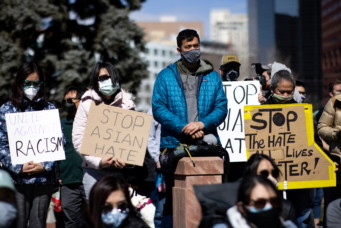Transforming Domestic Extremism in the United States
In the aftermath of the Capitol insurrection, efforts to counter domestic extremism should address the social and structural dynamics that contribute to violence.

An explosion caused by a police munition is seen while supporters of U.S. President Donald Trump gather in front of the U.S. Capitol Building in Washington, U.S., January 6, 2021. Leah Millis/Reuters
Together, the United States continues to struggle with how to respond to the violent insurrection at the Capitol on January 6, where thousands of Americans participated in what amounts to a violent coup attempt. Subsequent polling indicates that between 8 and 20 percent of Americans think the extremist violence was justified—in either case, that’s millions of people. While shocking in the scale by which regular Americans were involved, the Capitol insurrection was more an evolution of preexisting trends than a spontaneous revolution. Far-right extremist attacks have increased by over 250 percent globally since 2014.
Domestically, far-right violent extremism has accounted for nearly 60 percent of all targeted violence since 1994. Since September 11, 2001, more people have been killed by far-right wing than Islamist extremism in the United States. The magnitude of the challenge has left many people wondering what we can do to disengage people who have participated in or supported this kind of violence.
Already, the Biden Administration has responded with a plan to overhaul the government’s approach to counter domestic extremism. The new approach has three prongs: a comprehensive threat assessment by the intelligence community; elevating domestic extremism to the purview of the National Security Council; and ensuring cooperation among law enforcement and intelligence agencies. These are important steps that recognize the incongruence between the responses to domestic and foreign extremism— and begin to rectify that gap.
At the same time, the strategy to counter international terrorism has not been particularly successful. In the aftermath of 9/11, the need to do something resulted in short-sighted policies that restricted civil rights and deployed military forces into open-ended, costly, and destabilizing conflicts that often aggravated the dynamics that fuel violent extremism. Nearly twenty years after 9/11, violent extremist conflicts continue to rage across the Middle East, South Asia, the Sahel and West Africa, the Lake Chad Basin, Africa’s Great Lakes region, the Horn of Africa, Yemen, Libya, Ukraine, Afghanistan, and elsewhere. While territorially defeated in Iraq and Syria, ISIS loyalists remain resilient and continue to demonstrate global influence and worldwide reach. There have been many lessons learned since 2001; among the most important is that military and law-enforcement efforts alone are insufficient to counter violent extremism. The Biden strategy risks falling into the same trap of over-securitizing domestic extremism.
Isolation, Marginalization, and Social Bonds
Violent extremism is a form of behavior and an expression of conflict. Public health approaches to violence prevention and behavior change, and peacebuilding methods to resolve conflict and address underlying social challenges, are critical to addressing domestic violent extremism in the long run.
The securitization of violent extremism, however, has made the peacebuilding and public health communities reluctant to engage in the challenge. In fact, violent extremism is only one of many social challenges that result from a familiar set of risk factors and environments. In addition to violent extremism, the research on criminality, gang involvement, drug use, self-harm, intimate partner violence, population health, fragile states, and other forms of political violence all highlight strikingly similar themes regarding a host of social and political grievances. These include community resilience, stigma, marginalization, relative deprivation, lack of access to services, low levels of social trust, and unaddressed trauma.
Decades of practice and experience exist to address each of these challenges—yet violent extremism has been segregated into its own cage, viewed through the prisms of security and law enforcement and faulty assumptions that focus primarily on the individuals and ideologies involved.
But people mobilize to engage in extremism when a kaleidoscope of social and structural forces, as well as individual ones, intersect in just the right way, for just the right person, in just the right setting. The specifics of the process differ for everyone, but core elements include feelings of social exclusion and isolation, which often cause people to retreat into comfortable networks and interact more exclusively with people who share their values and frustrations.
The reasons people feel marginalized and alienated are vast. They can include trauma, which can destroy worldviews and result in a crisis of identity that makes it difficult to trust others or form social bonds; humiliation or shame at the inability to find or maintain employment, for example; hopelessness when trust in government institutions to adequately address needs is low; a need for respect and significance when opportunities for upward mobility are fleeting; or a whole host of behavioral and mental health idiosyncrasies that can make a person predisposed to violence or social influence. Add to this the tragic losses and necessary social distancing in response to the ongoing COVID-19 pandemic that has aggravated these feelings of isolation for many. Of course, neither trauma, isolation, nor frustrated agency can be considered wholesale risk factors for—nor can they excuse—engagement in violent extremism. The vast majority of traumatized and frustrated people never do so; but for those who do engage, such hardships are common.
When mainstream society isolates, fringe groups welcome. People seek out groups and voices that reflect their own values, principles, and lived experiences. Such networks are powerful because they offer social belonging and provide a source of identity. Groups such as QAnon have demonstrated how such networks can also become vectors for extremism.
As people search for answers to their frustrations, and legitimate channels seem inadequate or unable to rectify or even acknowledge their grievances, voices that present simplistic answers to complex questions, paint legitimate grievances and innate fears of sociocultural change as assaults on an entire social group or way of life, and misplace blame for the hardships they face can be appealing. When people feel like their identity is under assault, millions of years of inherited evolutionary biology kick in, and our brains respond in the same way that they would to physical threats—literally dehumanizing the assailants and removing cognitive inhibitions to using violence in defense of the group.
So President Trump deserves blame; his divisive rhetoric and policies preyed upon and amplified these dynamics to the benefit of his own political gain. He and his cabal stoked the flames for over four years; they are the spark that ignited the prairie fire. But the undercurrents that drive this kind of extremism run deeper than that. People don’t become violent extremists because of one person—violent extremism is inherently social in nature; it’s a form of collective action.
Countering domestic extremism will require addressing the individual, social, and structural dimensions of this problem. There are templates that exist—decades of research on how people exit roles and groups, including violent ones like armed groups and gangs, as well as ideological ones like cults. One common concept is that sustained, positive, and inclusive (or “prosocial”) interactions between people engaged in extremist networks and those from other social groups can build relationships and social bonds, generate empathy and a sense of belonging, and offer alternatives that reject violence.
Peacebuilders know firsthand how social and political systems that encourage social network diversity, inclusive representation, and equitable distribution of goods and services can moderate intergroup conflict and promote social cohesion. Research further demonstrates that expressions of compassion from even a single person from an opposing group can trigger reciprocal empathy toward that entire group. This is why simple demonstrations of empathy—such as a prison guard giving a Quran to a person incarcerated on terrorism-related charges—commonly feature in the stories of people who have disengaged from violent extremism as the moment that begins their exit. In this way, compassion and empathy are more powerful than ridicule and scorn.
Lowering Barriers and Opening Spaces
Identifying and removing barriers to prosocial interactions—by addressing the cognitive idiosyncrasies that contribute to isolation, the social stigmas that contribute to social exclusion, and the structural inequities that contribute to marginalization— can transform the ecosystems that sustain violent extremism.
First, behavioral and mental health investments can target many of the individual-level factors that drive violent and extremist behavior. We need to let go of our instinct to try and convince people that their ideology or values are wrong—even if they are. Applying pressure by arguing against deeply held beliefs will only cause people to retreat further into their ideological shelters, buttress their commitment, and erect psychological fortresses against change. And research has shown that people engaged in violent extremism are more likely to interact online with mental health content than with counter narrative content. Rather than trying to change beliefs and attitudes for people, we need to enable people to change them for themselves.
Public health practice has decades of experience with changing behavior and reducing harm by expanding care to stigmatized people who engage in risky behaviors. Improving access to behavioral healthcare can build more resilient individuals and communities by healing some of the psychosocial wounds and mental health challenges—such as trauma, fear, anxiety, shame, guilt, and hopelessness—that can be barriers to social engagement and keep people feeling isolated.
Unwavering ideological commitment to a cause is only one reason people may not seek help. Shame, embarrassment, hyper-masculine social norms, poor self-awareness, preferences for self-reliance, mistrust, low capacity, and lack of access to care are all barricades to help-seeking behavior. The Department of Health and Human Services has just as critical a role to play as the Department of Homeland Security.
There is no psychological pathology or clinical diagnosis that can pinpoint who will engage in violent extremism but addressing behavioral and mental health challenges that do exist can generate openings to meaningful change. Behavioral and mental health services won’t reach everyone, nor will they alone succeed in disengaging people without also addressing the social and structural elements that contribute to violent extremism, but they can crack open a willingness to listen in some people who would otherwise remain entirely closed off.
Second, restorative justice and reconciliation practices can provide accountability and redemption pathways that can invite people back into the community. Barriers to prosocial engagement do not only exist in individuals who have engaged in violent extremism; they also exist in the communities in which they live. Without open spaces wherein engagement can occur sincerely, communities cannot offer a tangible alternative.
Most Americans feel betrayed and angry over the events at the Capitol; people may be understandably reluctant to engage with those who support hateful ideologies. While people must be held accountable for their actions, millions of Americans who believe the insurrection was justified cannot be incarcerated. Even when the criminal justice system runs its course for those who led or participated in the insurrection, those returning from prison are likely to be further stigmatized and regarded with anger. But justice has a second face—restorative justice; and community-based accountability mechanisms, such as dialogues and truth processes, can provide a sense of justice, offer redemption, and enable reconciliation.
Such mechanisms have a global track record of success. Well known are the applications in Rwanda, where community-based Gacaca courts were adapted to ensure justice for victims of the genocide, and in South Africa, where the Truth and Reconciliation Commission provided a way forward for reconciliation and accountability after apartheid. Restorative justice has also proven viable in contexts more familiar to the United States. In Canada and Australia, truth commissions have helped to address the legacies of colonialism for indigenous peoples. In Victoria, British Columbia, community-based organizations partner with law enforcement to heal harms that result from crime and violence and divert people from the conventional justice system. And in the United States, community resources have been used to erode the effects of intimate partner violence, strengthen family connections and protect children, transform lives by providing justice that avoids incarceration, and promote racial equity and address the historical effects of racism.
Restorative justice does not mean forgive and forget; it’s about healing and moving forward together as a community. Indeed, healing cannot begin without accountability, but accountability need not always look like the inside of a prison cell. Restorative justice mechanisms can promote the just acknowledgment of and responsibility for harm. Respectful dialogue can involve entire communities and drive credible narratives of redemption in ways that the criminal justice system cannot. Redemption narratives have the unique ability to generate conciliatory intentions among those responsible without raising defensive reactions among those affected. Society functions as a looking glass; people tend to conform to the expectations of the labels that society provides. Restorative justice mechanisms enable people to earn a new label and adopt a new identity that rejects violence and hate.
The Elephant in the Room: Institutional Inequality
Dialogues must acknowledge not only the harm caused by supporting hateful violence; they must also acknowledge the legitimate grievances that contribute to violence.
Ultimately, those grievances—the structural, political, and economic inequities—need to be addressed. Of course, the vitriol directed at people of color and immigrants are not legitimate grievances; they are instead the distorted narratives peddled by manipulative elites and mainstreamed by social media echo chambers. Nonetheless, while the hateful beliefs themselves are not legitimate, many of the social and political dynamics that contribute to violent extremism are unjust.
Bruce Springsteen warned us back in 1983, “these jobs are going, . . . and they ain’t coming back.” The lyrics reflect a fundamental economic shift from manufacturing to healthcare, technology, and services. Yet, the labor market has failed to evolve in tandem, and people across the country have been left behind. Service-sector jobs are no longer just extra cash for high-school students or supplemental income for middle-class families; they’re increasingly a primary source of livelihood.
However, these jobs continue to be structured as if they are part-time work, forcing many families to rely on supplemental government programs. Wages have largely stagnated, especially for those without college education, and crippling student loan debt is forestalling home ownership, even for those who did attend college. The rich are getting richer and are insulated from the consequences of inaction.
The grievances aren’t just economic in nature—poverty is a cause for some people who engage in violent extremism. But there is no silver bullet, and addressing poverty and underemployment without regard for other social, structural, and political drivers of inequity and marginalization is not sufficient. Climate change is decreasing crop yields, increasing food insecurity, and making weather-related disasters more frequent and widespread. Politicians appear beholden to elite interests, and trust in political institutions—and each other—is at an all-time low. Moreover, generations of structural racism have created a society in which equity is perceived as status loss, and the social changes urgently needed drive uncertainty.
People will often need to disengage from violent extremism in these same environments, confronting the same hardships, surrounded by the same people facing the same lived experience as those that contributed to their engagement in the first place.
Many of these are generational challenges, but even incremental progress can alleviate tensions that make people feel marginalized and devoid of agency and increase social trust by demonstrating that political and civil participation is effective. Studies further show that social trust can mediate against violent extremism.
Progress involves reforming the political systems that favor the rich and the white, leaving people feeling victimized and divided. A more robust mental and behavioral health system can provide people with the skills they need to cope with the fears and uncertainties that can accompany this social change and accept complexity. Progress also involves making the economy more equitable and just so it provides opportunities and mobility for everyone regardless of race, class, or social standing. It involves reinvigorating civil society and nonviolent movements that can amplify voices of change, and it involves strengthening the social institutions that bridge divides and bring people together.
Behavioral health challenges as well as communal, political, and interpersonal violence, and conflict all contribute to engagement in violent extremism. Each of these elements also often persist after disengagement from it. Addressing this challenge requires concern not only for extremism but also a broader concern for wellbeing and other violent, antisocial, and adverse outcomes and behaviors. Curtailing extremist violence if frustrations are instead expressed through crime, substance abuse, or intimate partner violence cannot be the yardstick for success.
Placing the entire burden of change upon individuals without also building more resilient communities will not work. Addressing domestic extremism means transforming behaviors, transforming identities, and ultimately transforming conflict. It requires a hard look at the power structures and institutions that make people feel marginalized and powerless.
[End of Article]This essay was written in the author’s personal capacity. All opinions expressed are solely his own and do not represent those of his place of employment.





